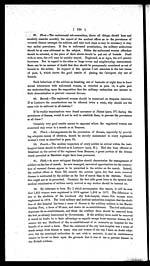Medicine - Institutions > Lock hospitals > Annual report on the working of the lock hospitals in the North-Western Provinces and Oudh > Fourth annual report on the working of the lock-hospitals in the North-Western Provinces and Oudh for the year 1877
(137) Page 129
Download files
Individual page:
Thumbnail gallery: Grid view | List view

(129)
At Sháhjahánpur the ratio of prevalence in. 1877 has been 305 per 1,000. For
the two previous years the mean ratio is 243 per 1,000. Deducting cases of secondary
syphilis, the ratio of 1877 falls to 227 per 1,000. But these cases cannot be deducted,
when the ratio of prevalence is required for purposes of comparison, as they were
included in the statements of previous years, and altogether it cannot be doubtful that
venereal disease is unduly prevalent at Shájahánpur. The medical officer's report
shows nothing as to the probable cause of this prevalence in 1877. In 1876 it was
attributed to the existence of unlicensed prostitution.
84. I think the evidence favouring the opinion that the increase of disease in
the previously mentioned four stations was due to unlicensed prostitution is too plainly
stated to make its correctness for a moment doubtful. This cause of hindrance to
successful lock-hospital management appears to have been more than usually prevalent
in 1877 because of' the prevalent distress.
In paras. 9, 10, and 13 this fact is very plainly stated, and there seems to be no
doubt that during the past year distress has led many poor women to practise prosti-
tution who in other years abstain from earning money in that way. And it further
appears from a perusal of the reports generally that—given the poor starving women
anxious to practise prostitution as a temporary means of livelihood—there is little, if
anything, in the regimental management active to prevent the soldiers from, taking
advantage of this widened field of selection.
In para. 75, indeed, it may be further seen that soldiers are able to contract disease
even from idiotic women wandering near cantonments.
85. Turning from the subject of the ill success of the year's operations in the
North-Western Provinces, it is satisfactory to consider the better results in Oudh.
The mean ratio of disease prevalence in the Oudh garrison in 1876 was 266 per
1,000; for 1877 it is 185 per 1,000.
This improvement is spread over the three garrisons of the province, but is most
apparent at Fyzabad and Lucknow, and I think it may serve a good purpose if I point
out the evident reasons for the success in these two places.
At Fyzabad, by reference, to para. 70, it may be seen that, under Dr. Evatt's
able management, good arrangements for the prevention of disease in the women's
apartments were maintained. The reality of these arrangements I can myself testify
to as the result of unexpected inspection.
The registered women have been subjected to unexpected examinations in their
rooms, and the weekly inspections have been most carefully performed. Lastly, the
town of Fyzabad has been placed out of bounds to the soldiers of the garrison, and
the soldiers have been taught to avoid disease.
At Lucknow, by reference to para. 61, it may be seen that, under Dr. Fair-
land's most careful management, the cantonment sub-committee have regularly passed
in review the subject of admissions to hospital from venereal diseases. The medical
inspections of all soldiers arriving at Lucknow has been effected with the best results.
The registered women have been examined twice a week. Fifty-one unlicensed women
have been arrested during the year, of whom 34 were suffering from disease.
The energy of the medical officer has been supplemented by the sensible action
of the military authorities, especially by the action of the general commanding, who
has placed certain portions of the city, at times of disease prevalence there, out of
bounds to the soldiers (para. 63).
86. I am strongly of opinion that the elements of success in regard to this
undertaking are to be found only in such management of the women and the soldiers
as characterized the arrangements at Fyzabad and Lucknow in 1877.
Set display mode to: Large image | Zoom image | Transcription
Images and transcriptions on this page, including medium image downloads, may be used under the Creative Commons Attribution 4.0 International Licence unless otherwise stated. ![]()
| Permanent URL | https://digital.nls.uk/75111243 |
|---|




